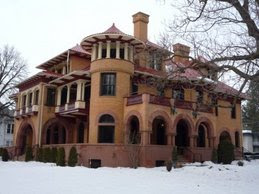 did some fine work. As I watched them present I thought to myself--Hey! I have a blog! I should share some of this stuff.
did some fine work. As I watched them present I thought to myself--Hey! I have a blog! I should share some of this stuff.Three of my students became interested in rephotography and created websites to present their work. Amber Chapin used Blogger to create a website: Kirtland Cutter Architecture: Then and Now. Cutter, was Spokane's most prominent architect of the late 19th and early 20th century and designed homes for the city elites as well as commercial buildings and even bridges. I like the way that Chapin found not only historic photographs but also blueprints for many of the Cutter buildings, and how she explored a variety of his work, not just the grand residences for which he is so locally famous.
James Dupey too quite a different tack in his project Historic
 Hillyard. Built as a depot town for James J. Hill's Great Northern Railroad in the late 19th century, Hillyard hit hard times as the railroad pulled out in the early 20th century and is today one of the most depressed neighborhoods in the state. But sometimes economic depression is the friend of preservation, and 85% of the historic buildings of Hillyard still stand.
Hillyard. Built as a depot town for James J. Hill's Great Northern Railroad in the late 19th century, Hillyard hit hard times as the railroad pulled out in the early 20th century and is today one of the most depressed neighborhoods in the state. But sometimes economic depression is the friend of preservation, and 85% of the historic buildings of Hillyard still stand.Chris Hendee did a rephotography project focused on Racine, Wisconsin. Racine, Hendee tells us, has always been a town of immigrants who brought an eclectic mix of architectural styles to the community. I was impressed by how much of the historic fabric is intact.
Michele Reid drew on her connections with Great Falls, Montana and her thesis research to create a fifteen-minute historical documentary film, Red Stars on the Horizon: The Seventh Ferrying Group in World War II. The Seventh Ferrying Group was composed on pilots, some of them women, who flew airplanes from American factories to the Soviet Union as part of the Lend-Lease program in World War Two.
Finally Meagan Yapp used Google Sites to create a simple website to host her interviews with women veterans. The website is a bit rough but the interviews are excellent.
It was fun watching the students stretch their abilities and practice history in new ways. They agreed that a digital project turned out to be more work than they had bargained for, but was very satisfying. At the same time I will make some changes next time around. Some of the projects presented history digitally but did very little analysis, as a teacher I need to emphasize the importance of interpretation. I wish I had pushed the geographic turn in digital history a bit more--most of the projects could have integrated a map function. And I need to emphasize more strongly the need for credits and attributions in student projects.
This quarter I am teaching Digital History for the first time and will be raising the bar for the students--stay tuned!

2 comments:
Interesting investigations!
Wish I had Digital history. Love to see how you teach this. I'm teaching on-line Pacific NW. Love to see a lesson on this.
Post a Comment